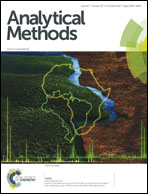Quantifying vitamin D and its metabolites by LC/Orbitrap MS†
Abstract
Establishing accurate and precise analytical methods for vitamin D species is of rising importance as awareness of the vitamin D deficiency problem grows. Here, we report an analytical method for quantifying vitamin D and relevant vitamin D metabolites by high-resolution mass spectrometry (HRMS). We combine a straightforward time saving sample preparation and chromatographic separation, employing gradients and a column-switching technique, with high-resolution MS detection, extending its applicability to a broader range of relevant vitamin D metabolites. We calibrated the method to NIST standards and validated it for 25(OH)D2 and 25(OH)D3. We also present short- and long-term sample-stability data and proof-of-concept by applying the method to serum samples from a healthy patient library that were previously measured by immunoassay. Compared to the immunoassay data, our method showed a good correlation of 25(OH)D3 concentrations. Thus, we show that quantitative HRMS is now within reach of clinical diagnostics for vitamin D and its metabolites.


 Please wait while we load your content...
Please wait while we load your content...